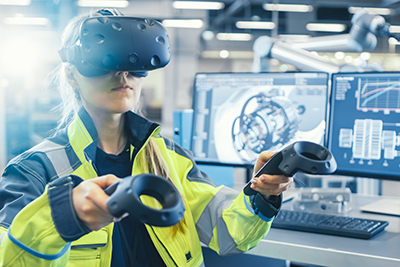
The latest advancements in machine vision are helping us to enhance what we see in everyday life. Thanks to both augmented and virtual reality, industries from manufacturing to healthcare to retail are evolving. Learn the difference between machine vision, AR, & VR and how they’re changing the world.
What Is Machine Vision?
Machine vision gives automated systems the gift of sight. They often consist of three parts. First, you need a camera. Specific to the application, machine vision cameras capture an image for analysis. Second, hardware paired with software algorithms interprets the image. Third, machine vision uses some kind of output to control an automated system.
AR and VR are blurring the lines between automation and human sensory input. Many machine vision systems are now sending information to monitors or heads-up displays. Instead of controlling a robot, machine vision is now allowing humans to make informed decisions in an augmented or virtual environment.
Comparing AR and VR Systems
Do you find it difficult to see the difference between augmented and virtual reality? You’re not alone. Even the experts admit the lines are blurred. Typically, virtual reality has referred to a completely virtual environment. But thanks to input from machine vision cameras and image datasets, it’s hard to see the difference between what’s real and generated.
Augmented reality blends real-world images with digital information. This is often made possible by overlaying 2D projected text or graphics over a transparent service or adding the text or graphics to a streaming video feed via embedded cameras. Instead of being totally computer-generated, AR incorporates real-world imagery in real-time.
The Latest Advancements in Machine Vision, AR, & VR
One battery cell manufacturer is using augmented reality to help train and guide workers. AR headsets with embedded cameras let workers see auxiliary information throughout their work processes. Less-experienced workers second-guess themselves less, make fewer mistakes, and shorten the time it takes them to assemble battery cells.
AR is also helping retailers to show off products to customers without ever having them enter the store. Thanks to AR-enabled smartphone apps, consumers can visualize furniture, paint schemes, and clothing from the comfort of their own homes. Computer vision-based AR is providing a better customer experience, boosting brands, and increasing sales.
VR is also having a major impact on the medical industry. Surgeons can view patient imaging in virtual reality environments. Universities and hospitals can use VR to train doctors on diagnoses and how to perform surgeries more precisely, resulting in less tissue damage and faster recovery times. VR is also now being used to treat PTSD, depression, and anxiety.
Machine vision is driving advancements in AR and VR technologies. SLAM allows for the real-time creation of 3D maps so everything from robotics to automobiles can navigate their environments. Surgeons, engineers, and other technicians can guide robots in 3D with their heads-up displays.
Choose a machine vision camera from Phase 1 Technology Corp for your next augmented or virtual reality application.
